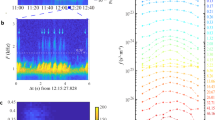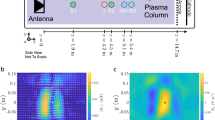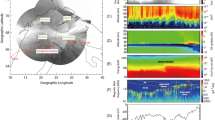Abstract
The most intense auroral emissions from Earth’s polar regions, called discrete for their sharply defined spatial configurations, are generated by a process involving coherent acceleration of electrons by slowly evolving, powerful electric fields directed along the magnetic field lines that connect Earth’s space environment to its polar regions1,2. In contrast, Earth’s less intense auroras are generally caused by wave scattering of magnetically trapped populations of hot electrons (in the case of diffuse aurora) or by the turbulent or stochastic downward acceleration of electrons along magnetic field lines by waves during transitory periods (in the case of broadband or Alfvénic aurora)3,4. Jupiter’s relatively steady main aurora has a power density that is so much larger than Earth’s that it has been taken for granted that it must be generated primarily by the discrete auroral process5,6,7. However, preliminary in situ measurements of Jupiter’s auroral regions yielded no evidence of such a process8,9,10. Here we report observations of distinct, high-energy, downward, discrete electron acceleration in Jupiter’s auroral polar regions. We also infer upward magnetic-field-aligned electric potentials of up to 400 kiloelectronvolts, an order of magnitude larger than the largest potentials observed at Earth11. Despite the magnitude of these upward electric potentials and the expectations from observations at Earth, the downward energy flux from discrete acceleration is less at Jupiter than that caused by broadband or stochastic processes, with broadband and stochastic characteristics that are substantially different from those at Earth.
This is a preview of subscription content, access via your institution
Access options
Access Nature and 54 other Nature Portfolio journals
Get Nature+, our best-value online-access subscription
$29.99 / 30 days
cancel any time
Subscribe to this journal
Receive 51 print issues and online access
$199.00 per year
only $3.90 per issue
Buy this article
- Purchase on Springer Link
- Instant access to full article PDF
Prices may be subject to local taxes which are calculated during checkout




Similar content being viewed by others
References
Ergun, R. E. et al. FAST satellite observations of electric field structures in the auroral zone. Geophys. Res. Lett. 25, 2025–2028 (1998)
Carlson, C. W., Pfaff, R. F. & Watzin, J. G. The Fast Auroral SnapshoT (FAST) mission. Geophys. Res. Lett. 25, 2013–2016 (1998)
Chaston, C. C. et al. The turbulent Alfvénic aurora. Phys. Rev. Lett. 100, 175003 (2008)
Amm, O . et al. Chapter 4: in situ measurements in the auroral plasma. Space Sci. Rev. 103, 93–208 (2002)
Cowley, S. W. H. & Bunce, E. J. Origin of the main auroral oval in Jupiter’s coupled magnetosphere–ionosphere system. Planet. Space Sci. 49, 1067–1088 (2001)
Hill, T. W. The Jovian auroral oval. J. Geophys. Res. 106, 8101–8107 (2001)
Ray, L. C., Ergun, R. E., Delamere, P. A. & Bagenal, F. Magnetosphere-ionosphere coupling at Jupiter: effect of field-aligned potentials on angular momentum transport. J. Geophys. Res. 115, A09211 (2010)
Connerney, J. E. P. et al. Jupiter’s magnetosphere and aurorae observed by the Juno spacecraft during its first polar orbits. Science 356, 826–832 (2017)
Mauk, B. H. et al. Juno observations of energetic charged particles over Jupiter’s polar regions: analysis of monodirectional and bidirectional electron beams. Geophys. Res. Lett. 44, 4410–4418 (2017)
Allegrini, F. et al. Electron beams and loss cones in the auroral regions of Jupiter. Geophys. Res. Lett. 44, http://doi.org/10.1002/2017GL073180 (2017)
Arnoldy, R. L. in Physics of Auroral Arc Formation (eds Akasofu, S.-I. & Kan, J. R. ) 56–66 (AGU, 1981)
Gérard, J.-C. et al. Mapping the electron energy in Jupiter’s aurora: Hubble spectral observations. J. Geophys. Res. 119, 9072–9088 (2014)
Gustin, J. et al. Characteristics of north Jovian aurora from STIS FUV spectral images. Icarus 268, 215–241 (2016)
Tao, C. et al. Variation of Jupiter’s aurora observed by Hisaki/EXCEED: 2. Estimation of auroral parameters and magnetospheric dynamics. J. Geophys. Res. 121, 4055–4071 (2016)
Mauk, B. H. et al. The Jupiter Energetic Particle Detector Instrument (JEDI) investigation for the Juno mission. Space Sci. Rev. http://doi.org/10.1007/s11214-013-0025-3 (2013)
Bonfond, B. et al. Morphology of the UV aurorae Jupiter during Juno’s first perijove observations. Geophys. Res. Lett. 44, 4463–4471 (2017)
McComas, D. J. et al. The Jovian Auroral Distributions Experiment (JADE) on the Juno mission to Jupiter. Space Sci. Rev. http://doi.org/10.1007/s11214-013-9990-9 (2013)
Krall, N. A. & Trivelpiece, A. W. Principles of Plasma Physics Ch. 3 (McGraw-Hill, 1973)
Grodent, D. et al. Jupiter’s polar auroral emissions. J. Geophys. Res. 108, 1366 (2003)
Janhunen, J., Olsson, A., Russell, C. T. & Laakso, H. Alfvénic electron acceleration in aurora occurs in global Alfvén resonosphere region. Space Sci. Rev. 122, 89–95 (2006)
Connerney, J. E. P. et al. The Juno magnetic field investigation. Space Sci. Rev. https://doi.org/10.1007/s11214-017-0334-z (2017)
Connerney, J. E. P., Acuña, M. H., Ness, N. F. & Satoh, T. New models of Jupiter’s magnetic field constrained by the Io flux tube footprint. J. Geophys. Res. 103, 11929–11939 (1998)
Gladstone, G. R. et al. The ultraviolet spectrograph on NASA’s Juno mission. Space Sci. Rev. https://doi.org/10.1007/s11214-014-0040-z (2014)
Hess, S. L. G., Bonfond, B., Zarka, P. & Grodent, D. Model of the Jovian magnetic field topology constrained by the Io auroral emissions. J. Geophys. Res. 116, A05217 (2011)
Mauk, B. H. et al. Energetic ion characteristics and neutral gas interactions in Jupiter’s magnetosphere. J. Geophys. Res. 109, A09S12 (2004)
Bolton, J. S. et al. Jupiter’s interior and deep atmosphere: the initial pole-to-pole passes with the Juno spacecraft. Science 356, 821–825 (2017)
Acknowledgements
We are grateful to NASA and contributing institutions that helped to make the Juno mission possible. This work was funded by NASA’s New Frontiers Program for Juno via subcontract with the Southwest Research Institute.
Author information
Authors and Affiliations
Contributions
B.H.M. is lead investigator for the Juno JEDI investigation, created Figs 1, 3 and 4 and analysed the data. D.K.H. operated the JEDI instruments during the Juno polar passes. C.P. coordinated planning of the instruments for the Juno polar passes. G.C. determined the JEDI efficiencies for quantifying the intensities of the particle fluxes. P.K. determined the out-of-band sensitivities of the JEDI instrument. A.M.R. developed the procedure for removing the minimum ionizing contamination of the electron spectra due to high-energy penetrators. S.J.B. is the principal investigator of the Juno mission. S.M.L. is a project scientist on the Juno mission. A.A. is lead investigator for the Juno Infra-Red Auroral Imager (JIRAM), helped to plan the Juno polar encounters and interpreted the auroral images. F.A. is a member of the Juno JADE plasmas sensor, helped to plan the Juno auroral encounters and interpreted the particle measurements. F.B. helped to plan the Juno polar encounters and performed the magnetic mapping of the Juno trajectory to the auroral atmosphere. B.B. is a member of the UVS imaging team and interpreted the Juno UVS auroral images. J.E.P.C. is lead investigator of the Juno magnetometer instrument and provided the magnetic field data necessary for ordering the particle data in Figs 1, 3 and 4. G.R.G. is lead investigator of the Juno UVS instrument and generated Fig. 2. W.S.K. is lead investigator of the Juno Waves investigation and helped to plan and interpret the observations of Jupiter’s polar regions. D.J.M. is the lead developer of the Juno JADE plasma instrument and helped to interpret the electron measurements. P.V. is the lead investigator for the Juno JADE instrument, and helped to plan the Juno polar encounters and interpret the electron measurements.
Corresponding author
Ethics declarations
Competing interests
The authors declare no competing financial interests.
Additional information
Reviewer Information Nature thanks J. Clarke, T. Cravens and the other anonymous reviewer(s) for their contribution to the peer review of this work.
Publisher's note: Springer Nature remains neutral with regard to jurisdictional claims in published maps and institutional affiliations.
Extended data figures and tables
Extended Data Figure 1 Energetic electron data during the PJ3 encounter with Jupiter’s polar regions (11 December 2016).
Same as Fig. 4b–d, but showing a greatly extended period of time that encompasses the entire northern polar pass. The horizontal brightening centred near 150 keV in b, particularly in the radiation belts, is the minimum ionizing feature discussed in Methods.
Rights and permissions
About this article
Cite this article
Mauk, B., Haggerty, D., Paranicas, C. et al. Discrete and broadband electron acceleration in Jupiter’s powerful aurora. Nature 549, 66–69 (2017). https://doi.org/10.1038/nature23648
Received:
Accepted:
Published:
Issue Date:
DOI: https://doi.org/10.1038/nature23648
This article is cited by
-
Drifting discrete Jovian radio bursts reveal acceleration processes related to Ganymede and the main aurora
Nature Communications (2023)
-
Kinetic Alfvén waves and auroral particle acceleration: a review
Reviews of Modern Plasma Physics (2023)
-
Observation and origin of non-thermal hard X-rays from Jupiter
Nature Astronomy (2022)
-
The in-situ exploration of Jupiter’s radiation belts
Experimental Astronomy (2022)
-
Active auroral arc powered by accelerated electrons from very high altitudes
Scientific Reports (2021)
Comments
By submitting a comment you agree to abide by our Terms and Community Guidelines. If you find something abusive or that does not comply with our terms or guidelines please flag it as inappropriate.



